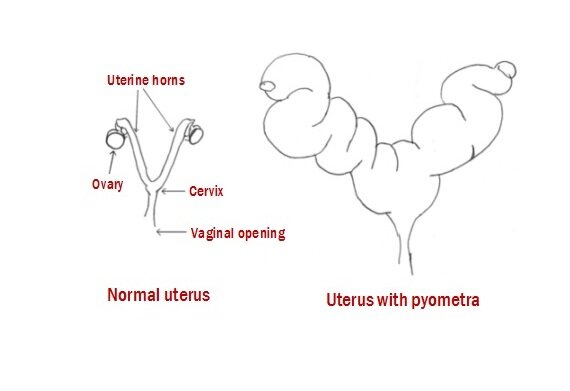Feline Pyometra: Symptoms, Causes, and Treatment
The word "Pyometra" derives from Latin "Pyo," meaning pus, and "metra," meaning uterus. Feline Pyometra is an abscessed, pus-filled, infected uterus. Toxins and bacteria leak across the uterine walls and into the bloodstream, causing life-threatening toxic effects. Without treatment, death's inevitable.
What are the precursors to Pyometra?
Pyometra's a serious issue and can be a life-threatening condition that requires quick and aggressive treatment. Feline Pyometra happens from many different things, with E. coli and Staph infections being the two leading causes. Pyometra is a secondary infection due to hormonal changes in an un-spayed cat's reproductive tract. Following a "heat" cycle (feline estrus), the progesterone levels can remain elevated for several weeks. With each heat cycle, the uterine lining engorges in preparation for pregnancy. Hormonal changes can activate infection during this time. With each estrus cycle, the possibility of a cyst can form. If the cyst does form, it becomes fluid-filled. Eventually, some tissue engorgement becomes excessive or persistent (a condition called "cystic endometrial hyperplasia"). This lush glandular tissue is ripe for infection.
The uterine cyst will start secreting fluids. These fluids create an ideal environment for bacteria to habituate and grow. Another side effect of the high progesterone levels is preventing the uterine walls from contracting and expelling the fluids and bacteria. During estrus, the cervix opens, and bacteria are allowed to enter. Bacteria ascend from the vagina, and the uterus becomes infected, getting trapped as the cervix closes and is ultimately pus-filled. The warm and wet environment's perfect for the growing of the bacteria. E-coli and streptococcus are part of the normal bacteria in the vagina and are a frequent cause of bacterial Pyometra.
One other factor that contributes to Pyometra is white blood cells (WBC). While WBC's naturally fight bacteria, during estrus, WBC's cannot enter the uterus. This is a normal occurrence to allow the male's sperm to enter the female's productive tract without harm or death from the WBC's. It's this combination that leads to the development of Pyometra.
What are the symptoms of Pyometra?
Unfortunately, there are not always symptoms, but fortunately, Pyometra's not nearly as common as one might think. Classically, the patient is a younger female cat. Usually, a cat has just finished a heat cycle in the previous 1-2 months. She may develop a poor appetite and may vomit or drink an excessive amount of water.
In the more usual "open Pyometra," the cervix is open, and the purulent uterine contents can drip out; thus, a smelly vaginal discharge is usually apparent. A female with open Pyometra is much easier to treat because the cervix is already open.
There's also a form of feline Pyometra called a "closed Pyometra," meaning the cervix is closed. There's no vaginal discharge in these cases, and the clinical presentation is more difficult to diagnose. These cats also tend to be sicker than those with open Pyometra due to the retention of toxic uterine contents. Lab work shows a pattern typical of a widespread infection, often helpful in narrowing down the diagnosis. Radiographs may show a gigantic, distended uterus--though sometimes this isn't obvious, and an ultrasound needed to confirm the diagnosis.
Pyometra causes are: Promoted from a secondary systemic bacterial infection, post-copulation, cystic endometrial hyperplasia, estrogen (to treat vaginitis), post-partum metritis, or spontaneously.
The illustrations of both a normal uterus and a Pyometra-filled uterus.
Is there an alternative to surgery?
Antibiotics alone WILL NOT cure Pyometra. Treatment or spaying is the only two treatments. In the late 1980s, another treatment protocol became available that might spare a valuable animal's reproductive capacity. Here, special hormones called "prostaglandins" are given as injections to cause the uterus to contract and expel its contents. The main prostaglandin used is (Lutalyse®), which causes cramping. A week of hospitalization's necessary for this treatment. Lutalyse® isn't advised for "closed" Pyometra because the "prostaglandins" can cause the cervix to open. The risks of using a hormone to force the uterus to contract can also cause it to explode, killing the female. I've successfully treated a Maine Coon, and a Savannah Cat with closed Pyometra and both went on to have successful litters.
Here are some vital statistics that you should know about this form of prostaglandin treatment:
• The success rate for treating open-cervix Pyometra is 75-90%
• The success rate for treating closed-cervix Pyometra is 25-30%
• The rate of recurrence of the disease is 50-75%
• The chances of subsequent successful breeding are 50-75%
PROS: There's a possibility of a future pregnancy for the patient (though often there's too much uterine scarring). Avoid surgery with concurrent problems that pose an additional anesthetic risk. If a female cat isn't of significant genetic value, it's best to spay.
CONS: 1.) Feline Pyometra can reoccur. 2.) There's a possibility of uterine rupture with the contractions. A ruptured uterus would cause peritonitis and escalates the life-threatening nature of the disease.
If a person decides to treat with prostaglandins for Pyometra and the treatment's successful, the cat "must" be bred on the very next heat cycle. If not bred, the likelihood of a recurrence is very high.
Treating a female with Pyometra with prostaglandins.
First and foremost, DO NOT attempt to treat at home. A veterinarian MUST be involved. An ultrasound to diagnose is essential, as well as two or three ultrasounds during treatment. Treating Pyometra can be quite expensive.
A patient is injected with prostaglandin twice daily. This injection forces the uterus to contract, squeezing out the pus. The treatment requires the use of two antibiotics together, Baytril and Clavamox. After three days of treatment, another ultrasound is necessary to determine if the pus-filled uterus is getting smaller. If so, the therapy continues, with another ultrasound towards the end of treatment. Some cats may require ten days of treatment.
Once the prostaglandin treatment's finished, antibiotic therapy will continue for two more weeks with the Baytril and Clavamox. Then there will be two more weeks with the Clavamox alone, equaling one month of antibiotic treatment.
I kept mine on Amoxicillin with the veterinarians OK until we bred them again. With the Maine Coon, it was only three weeks later when she came into heat. The Savannah cat was nearly two months.
What's likely to happen if I do nothing?
The chance of successful treatment without surgery or prostaglandin treatment is extremely low. The toxic effects from the bacteria will be fatal without quick treatment. If the cervix is closed, it's also possible for the uterus to rupture, spilling the infection into the abdominal cavity, which is also deadly.
This article is by Gary Fulgham and may not be copied, reproduced, or reprinted without written authorization.
Disclaimer: Any medical advice given here is strictly the author's opinion and not intended as advice. It's not intended to diagnose or offer treatment for an individual animal. Always consult a qualified veterinarian for any medical condition.
BEFORE YOU GO, WE NEED YOUR HELP TO MOVE UP THE RANKS ON GOOGLE!
Help SAVANNAHGANS® Grow and Reach Every Savannah Cat-Owning Household! All support is humbly appreciated (visit the clickable underlined links).
Subscribe (free) (by visiting the banner on our home page) and receive each quarterly issue to your inbox.
Share this article on your own social media platforms.
Leave a Comment. (this is VERY helpful to our growth and Google recognition)
Follow on Instagram.
Follow on Twitter.
Follow on Pinterest.
Follow on Youtube.


